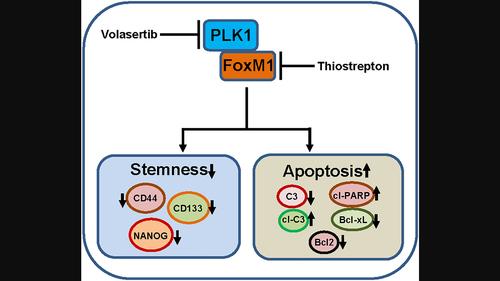当前位置:
X-MOL 学术
›
Mol. Oncol.
›
论文详情
Our official English website, www.x-mol.net, welcomes your feedback! (Note: you will need to create a separate account there.)
PLK1 and FoxM1 expressions positively correlate in papillary thyroid carcinoma and their combined inhibition results in synergistic anti-tumor effects
Molecular Oncology ( IF 6.6 ) Pub Date : 2024-02-15 , DOI: 10.1002/1878-0261.13610 Pratheesh Kumar Poyil 1 , Abdul K. Siraj 1 , Divya Padmaja 1 , Sandeep Kumar Parvathareddy 1 , Saravanan Thangavel 1 , Khadija Alobaisi 1 , Roxanne Diaz 1 , Rafia Begum 1 , Wael Haqawi 1 , Saif S. Al‐Sobhi 2 , Fouad Al‐Dayel 3 , Khawla S. Al‐Kuraya 1
Molecular Oncology ( IF 6.6 ) Pub Date : 2024-02-15 , DOI: 10.1002/1878-0261.13610 Pratheesh Kumar Poyil 1 , Abdul K. Siraj 1 , Divya Padmaja 1 , Sandeep Kumar Parvathareddy 1 , Saravanan Thangavel 1 , Khadija Alobaisi 1 , Roxanne Diaz 1 , Rafia Begum 1 , Wael Haqawi 1 , Saif S. Al‐Sobhi 2 , Fouad Al‐Dayel 3 , Khawla S. Al‐Kuraya 1
Affiliation

|
Polo-like kinase 1 (PLK1; also known as serine/threonine-protein kinase PLK1) serves as a central player in cell proliferation, exerting critical regulatory roles in mitotic processes and cell survival. We conducted an analysis of PLK1 protein expression in a large cohort of samples from papillary thyroid carcinoma (PTC) patients and examined its functional significance in PTC cell lines, both in vitro and in vivo. PLK1 overexpression was noted in 54.2% of all PTC and was significantly associated with aggressive clinicopathological parameters; it was also found to be an independent prognostic marker for shorter recurrence-free survival. Given the significant association between PLK1 and forkhead box protein M1 (FoxM1), and their concomitant overexpression in a large proportion of PTC samples, we explored their correlation and their combined inhibitions in PTC in vitro and in vivo. Inhibition of PLK1 expression indeed suppressed cell proliferation, leading to cell cycle arrest and apoptosis in PTC cell lines. Significantly, the downregulation of PLK1 reduced the self-renewal capability of spheroids formed from PTC cells. Immunoprecipitation analysis shows that PLK1 binds to FoxM1 and vice versa in vitro. Mechanistically, PLK1 knockdown suppresses FoxM1 expression, whereas inhibition of FoxM1 does not affect PLK1 expression, which suggests that PLK1 acts through the FoxM1 pathway. The combined treatment of a PLK1 inhibitor (volasertib) and a FoxM1 inhibitor (thiostrepton) demonstrated a synergistic effect in reducing PTC cell growth in vitro and delaying tumor growth in vivo. This study highlights the important role of PLK1 in PTC tumorigenesis and prognosis. It also highlights the synergistic therapeutic potential of dual-targeting PLK1 and FoxM1 in PTC, unveiling a potential innovative therapeutic strategy for managing aggressive forms of PTC.
中文翻译:

PLK1和FoxM1在甲状腺乳头状癌中表达呈正相关,联合抑制可产生协同抗肿瘤作用
Polo 样激酶 1(PLK1;也称为丝氨酸/苏氨酸蛋白激酶 PLK1)是细胞增殖的核心参与者,在有丝分裂过程和细胞存活中发挥关键的调节作用。我们对来自甲状腺乳头状癌 (PTC) 患者的大量样本中的 PLK1 蛋白表达进行了分析,并在体外和体内检查了其在 PTC 细胞系中的功能意义。在 54.2% 的 PTC 中发现PLK1过度表达,并且与侵袭性临床病理参数显着相关;它还被发现是较短无复发生存期的独立预后标志。鉴于 PLK1 和叉头盒蛋白 M1 (FoxM1) 之间的显着关联,以及它们在大部分 PTC 样本中伴随的过度表达,我们探讨了它们的相关性以及它们在体外和体内对 PTC 的联合抑制作用。抑制 PLK1 表达确实抑制了细胞增殖,导致 PTC 细胞系细胞周期停滞和凋亡。值得注意的是,PLK1 的下调降低了 PTC 细胞形成的球体的自我更新能力。免疫沉淀分析表明,在体外, PLK1 与 FoxM1 结合,反之亦然。从机制上讲,PLK1敲低会抑制 FoxM1 表达,而FoxM1的抑制不会影响 PLK1 表达,这表明 PLK1 通过 FoxM1 途径发挥作用。PLK1抑制剂(volasertib)和FoxM1抑制剂(thiostrepton)的联合治疗在体外减少PTC细胞生长和延缓体内肿瘤生长方面表现出协同作用。这项研究强调了 PLK1 在 PTC 肿瘤发生和预后中的重要作用。它还强调了双靶向 PLK1 和 FoxM1 在 PTC 中的协同治疗潜力,揭示了治疗侵袭性 PTC 的潜在创新治疗策略。
更新日期:2024-02-15
中文翻译:

PLK1和FoxM1在甲状腺乳头状癌中表达呈正相关,联合抑制可产生协同抗肿瘤作用
Polo 样激酶 1(PLK1;也称为丝氨酸/苏氨酸蛋白激酶 PLK1)是细胞增殖的核心参与者,在有丝分裂过程和细胞存活中发挥关键的调节作用。我们对来自甲状腺乳头状癌 (PTC) 患者的大量样本中的 PLK1 蛋白表达进行了分析,并在体外和体内检查了其在 PTC 细胞系中的功能意义。在 54.2% 的 PTC 中发现PLK1过度表达,并且与侵袭性临床病理参数显着相关;它还被发现是较短无复发生存期的独立预后标志。鉴于 PLK1 和叉头盒蛋白 M1 (FoxM1) 之间的显着关联,以及它们在大部分 PTC 样本中伴随的过度表达,我们探讨了它们的相关性以及它们在体外和体内对 PTC 的联合抑制作用。抑制 PLK1 表达确实抑制了细胞增殖,导致 PTC 细胞系细胞周期停滞和凋亡。值得注意的是,PLK1 的下调降低了 PTC 细胞形成的球体的自我更新能力。免疫沉淀分析表明,在体外, PLK1 与 FoxM1 结合,反之亦然。从机制上讲,PLK1敲低会抑制 FoxM1 表达,而FoxM1的抑制不会影响 PLK1 表达,这表明 PLK1 通过 FoxM1 途径发挥作用。PLK1抑制剂(volasertib)和FoxM1抑制剂(thiostrepton)的联合治疗在体外减少PTC细胞生长和延缓体内肿瘤生长方面表现出协同作用。这项研究强调了 PLK1 在 PTC 肿瘤发生和预后中的重要作用。它还强调了双靶向 PLK1 和 FoxM1 在 PTC 中的协同治疗潜力,揭示了治疗侵袭性 PTC 的潜在创新治疗策略。



























 京公网安备 11010802027423号
京公网安备 11010802027423号